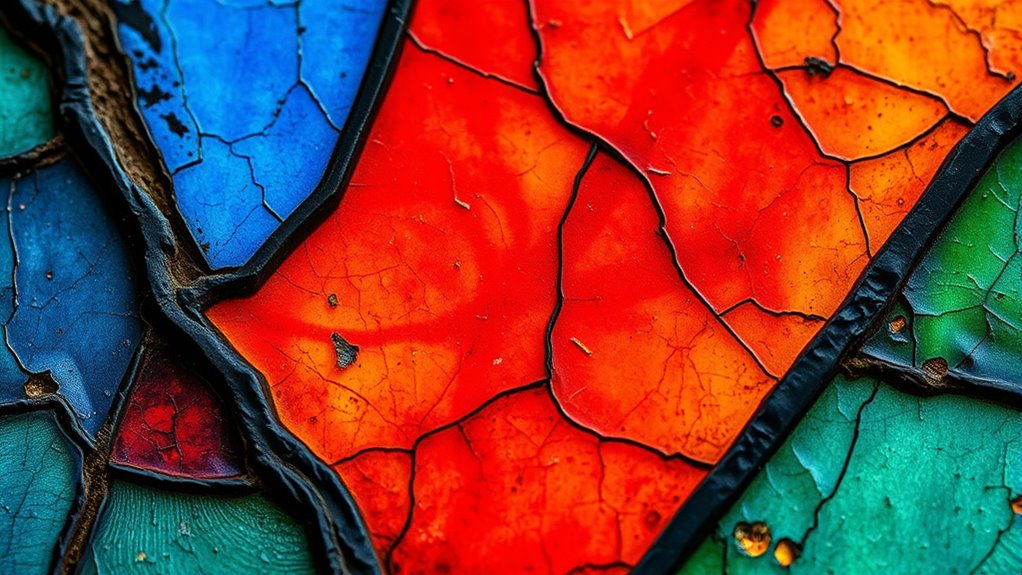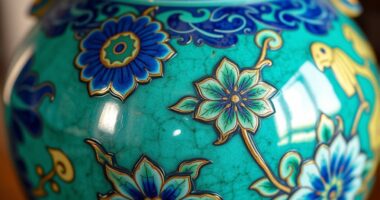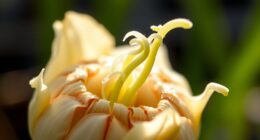The lost art of medieval stained glass pigments involves a deep understanding of chemical compositions and artistic techniques that artisans carefully developed. They used mineral powders, binders, and firing methods to create vibrant, durable colors like gold reds and copper greens. The mastery of layering, shading, and firing results in luminous windows that have withstood centuries. If you want to uncover how these techniques combined science and art, keep exploring to see how modern researchers are unraveling their secrets.
Key Takeaways
- Medieval stained glass pigments relied on specific mineral compounds like gold leaf and copper to produce vibrant, durable colors.
- Techniques involved grinding minerals into fine pastes and using binders, then firing in kilns to fuse pigments with glass.
- Artists layered and shaded pigments, controlling firing temperatures to achieve desired depth, transparency, and color effects.
- Much of the traditional knowledge was lost over time, making modern replication of medieval vibrancy challenging.
- Scientific research uncovers historical pigment compositions and application methods, helping preserve and emulate this lost art.

Have you ever wondered how medieval artisans created those vibrant, luminous stained glass windows that still captivate us today? The secret lies in their mastery of pigments, a blend of chemistry and artistry that has largely been lost to time. These artisans understood the importance of the chemical composition of their pigments, carefully selecting and combining raw materials to produce the brilliant reds, blues, greens, and yellows that make their windows so striking. For example, they used gold leaf to achieve deep, rich reds, and copper compounds for vivid greens and blues. The chemical composition of these materials determined not only the color but also how the pigment would interact with light and how durable it would be over centuries. Their understanding of chemical interactions played a crucial role in ensuring their creations stood the test of time.
Medieval artisans mastered pigment chemistry to create vibrant, durable stained glass windows that captivate us today.
Their artistic techniques involved more than just mixing pigments; they mastered the process of applying and firing them onto glass to ensure vibrant, long-lasting color. They would first create a paint-like mixture by grinding mineral powders into a fine paste, often incorporating binders like gum arabic or egg yolk to make the pigment adhere to the glass surface. This meticulous process required precision, as the pigment had to be applied evenly and with an understanding of how it would react during firing or cooling. When the painted glass was reheated in a kiln, the pigments fused with the glass, creating a seamless, luminous surface that could withstand the test of time.
The use of artistic techniques extended to layering and shading, giving depth and dimension to the images. Artists would apply multiple layers of pigment, adjusting the thickness to achieve different shades and effects. They understood how variations in firing temperature could alter the final appearance, controlling the intensity and transparency of the colors. These techniques were passed down through generations, with artisans refining their methods to produce increasingly sophisticated works.
Today, we marvel at medieval stained glass, but the knowledge behind their creation is only partially understood. Modern science is uncovering details about the chemical composition and artistic techniques that made these windows so mesmerizing. Despite advances in technology, replicating the exact vibrancy and luminosity of medieval glass remains a challenge, as much of the traditional craftsmanship and chemical understanding has been lost. Still, by studying these historical methods, we gain insight into a remarkable fusion of science and art that produced some of the most beautiful stained glass windows in history.
Frequently Asked Questions
How Did Medieval Artisans Achieve Vibrant Red Hues?
You discover that medieval artisans achieved vibrant red hues using historical pigment recipes involving materials like cinnabar and minium. These pigments were highly prized, and trade route impacts allowed access to rare ingredients from distant lands. By carefully grinding and mixing these substances, artisans created rich, lasting reds that enhanced stained glass windows, reflecting their skill and the influence of trade in making such vibrant colors possible.
Were Any Pigments Unique to Specific Regions?
They say, “You are what you eat,” but in medieval stained glass, you’re also where you’re from. Yes, regional pigment variations existed, influenced by trade routes and local resources. Certain hues, like Egyptian blue or Tyrian purple, were unique to specific areas due to trade access or raw material availability. This regional diversity added rich depth and cultural identity to medieval stained glass, making each piece a vibrant story of its origins.
How Did Pigment Availability Influence Church Designs?
You see, pigment availability directly shaped church designs by influencing medieval color symbolism and stained glass preservation. When certain colors were scarce, artisans used what was available, making each window unique and meaningful. Limited pigments meant some hues became symbols of specific virtues or themes. This scarcity encouraged ingenuity, ensuring that stained glass not only told religious stories but also reflected regional resources, enriching the spiritual experience.
What Modern Techniques Mimic Medieval Stained Glass Colors?
Imagine capturing medieval glass making’s vibrant spirit with modern tools. Today, artisans mimic those rich colors using advanced techniques like digital printing and specialized glass coatings. They draw inspiration from historic pigment trade routes, recreating the hues once sourced through long, arduous journeys. These methods allow you to achieve authentic-looking stained glass colors, preserving the medieval aesthetic while leveraging contemporary innovations to bring ancient artistry to life again.
Did Pigment Recipes Change Over the Medieval Period?
You might wonder if pigment recipes changed during medieval times. Over this period, trade expanded, bringing new materials and colors, which influenced pigment recipes. However, the core techniques for making and applying these pigments remained quite consistent. Preservation efforts today help us understand these historic recipes better, revealing how medieval craftsmen maintained vibrant stained glass despite evolving trade routes and resource availability.
Conclusion
You now see how the lost art of medieval stained glass pigments connects craftsmanship to history, tradition to innovation, and artistry to preservation. You understand the importance of uncovering ancient secrets, of reviving fading techniques, and of honoring the masters who created masterpieces. By appreciating these pigments, you not only preserve a rich cultural legacy but also embrace the timeless beauty that continues to inspire. In remembering the past, you shape the future of stained glass artistry.









